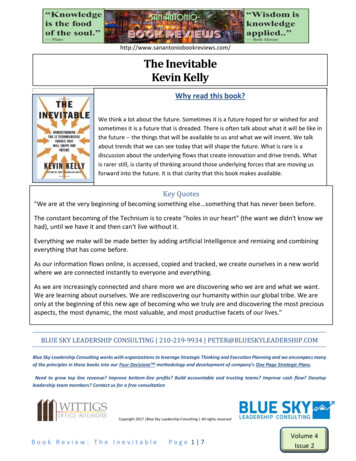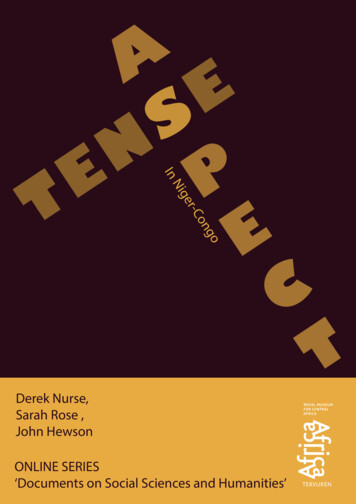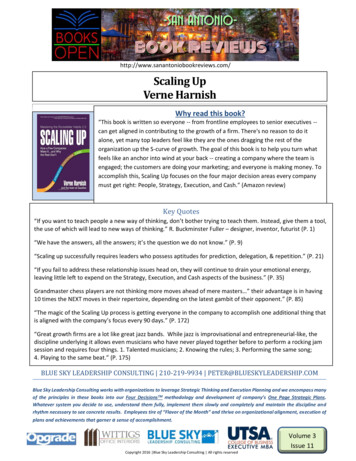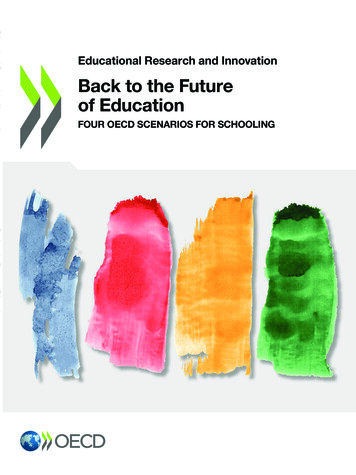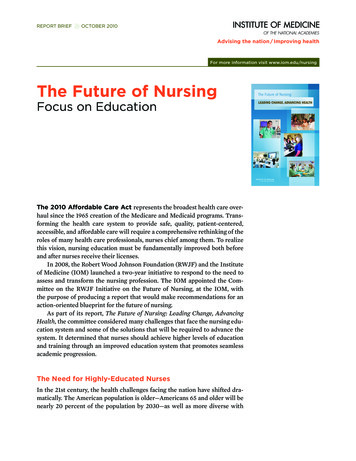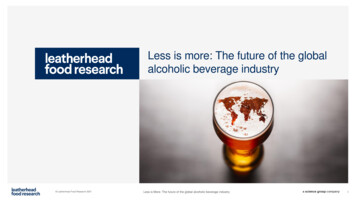
Transcription
Less is more: The future of the globalalcoholic beverage industry Leatherhead Food Research 2021Less is More: The future of the global alcoholic beverage industry1
We help our clients toinnovate, access newmarkets and realiseglobal opportunities infood and beverage Global regulatory affairs Consumer science Analytical science Membership services Leatherhead Food Research 2021 500 foodand beverageprojects peryear100 years inoperation20 languages150 territoriesLess is More: The future of the global alcoholic beverage industryTwo R&Dcentreswith 15,000m2of labs2
Dr Adam FentonOver the next half an hour or so, we will providedata and insight into:VP – F&B Consulting Why being natural can help satisfy yourconsumers needsLeatherhead Food Research That consumers searching for a healthieralternative don’t only want an alcohol free drink The drivers that those very same consumershave when they choose their ‘adult’ oralternative drinksJenny Arthur Why some of these adult drinks are struggling toget a foot hold in the marketHead of Nutrition and Membership The importance of communication in maintainingconsumption patternsLeatherhead Food Research Leatherhead Food Research 2021Less is More: The future of the global alcoholic beverage industry3
Agenda1 Introduction; history, health & wellness2 Less is more3 The consumer need: Our study4 Learnings and summary5 Q&A Leatherhead Food Research 2021Less is More: The future of the global alcoholic beverage industry4
Section 1Introduction;History, Health & Wellness Leatherhead Food Research 2021Less is More: The future of the global alcoholic beverage industry5
History1972 - Dr Robert Atkins published his first book - Dr Atkins’ Diet Revolution1992 - Updated publication - New Diet Revolution2002 - Concept of “net carb” was first introduced and the ‘Atkins Diet’2002 also saw the launch of Michelob Ultra: Originally targeted at over 50s Significant growth in 20 - 30 year olds Captured a large proportion of female drinkersToday Michelob Ultra holds notable presence in the USreflecting a growing consumer sentiment.Consumers do want a beer, a wine, a cocktail, a whisky.They want something more which often requires less. Leatherhead Food Research 2021Less is More: The future of the global alcoholic beverage industry6
The relationship with health and wellnessA healthy lifestyle can have a profound effect on physical and mental wellbeing.Excessive consumption of traditional alcoholic drinks can adversely affect health. In 2017 alcohol consumption in the UK had reduced by 16%since 2004 In 2017 45 - 64 year olds the most likely to drink and 16 - 24year olds the least likely to drink in the UK With declining alcoholic intakes, consumers are looking forlower/no alcohol products Consumers are also interested in products that will deliveragainst their health and wellness agendaAlcohol statistics Alcohol Change UK Leatherhead Food Research 2021Less is More: The future of the global alcoholic beverage industry7
Section 2Less is more Leatherhead Food Research 2021Less is More: The future of the global alcoholic beverage industry8
Less is moreManufacturers now produce a range of alcoholic drinks, and alternatives that address consumer needs ofhealth and wellness. These alternatives focus on: Lowering the alcohol Lowering the carbohydrates / calories Reducing total consumptionWith these issues in mind, manufacturers need to consider ingredients, claims, labelling as well as productstability/quality to address the consumer need.Yuengling LightLager - 99 calorieson the bottle Leatherhead Food Research 2021Kopparberghard seltzer 93 calories onthe canHayman’s Small Ginhas elevated botanicalcharacter requiring 5mlof gin in a G&TLess is More: The future of the global alcoholic beverage industryBrachetto D'AcquiItalian SparklingRed at 7% ABV9
What consumers are looking for Whilst products are offering less alcohol or calories,consumers are expecting more: Information about the ingredients, the way theproduct is made and its nutritional facts Variety in products that they can purchase Accessibility for those that they cannotConsumers are being more mindful aboutthemselves, and also the environment – beingnatural is a top concern and linked with physicalhealth and mental wellness.Make more alcoholic drinks made with natural ingredientsavailableMake more low-alcohol alcoholic drinks available23%Make more lower-calorie alcoholic drinks available23%Provide better nutritional labelling on the packaging Leatherhead Food Research 202121%Make more flavoursome alcoholic drinks available17%Increase access/ make it easier to access alcoholic drinks fromacross the world that are not currently available in my country 16%Provide better explanation of where their alcoholic drinks aremade (e.g. explained on packaging, in videos on their 16%Show the processes and ingredients used in making thealcoholic drinks (e.g. explained on packaging, in videos on 16%Make more alcoholic drinks with new and interesting ingredientsavailableDon't knowNone of theseConsumers are developing an awarenesssub-health that drinks producers can address25%15%12%22%Figure 1: ‘Thinking generally about what you know about brands in the alcoholic drinksindustry.In general, which, if any, of the following would you like to see brands in thealcoholic drinks industry do more of?(Please select all that apply)’. N 9669Less is More: The future of the global alcoholic beverage industry10
What is sub-optimal health or subhealth?Health is defined in by the World Health Organisation in their constitution as:"a state of complete physical, mental, and social well-being and not merely the absence of disease orinfirmity.“ Constitution (who.int)Wang and his team at ECU define sub-optimal health as"a physical state between health and disease,"characterized by ambiguous health complaints as wellas general weakness and periods of low energy.ECU World Class Suboptimal health ResearchIndividuals display symptoms of illness but without thediagnosis of disease, with underlying causes such as: Stress Sleep deprivation Lack of exercise Inadequate and unhealthy diets Leatherhead Food Research 2021Less is More: The future of the global alcoholic beverage industry11
Section 3The consumer need: Our study Leatherhead Food Research 2021Less is More: The future of the global alcoholic beverage industry12
Our studyWe found that: Natural is key when considering purchasing drinks Alcohol-free may be the direction that manufacturers are goingas there is a clear definition, but it is not as simple as that forconsumers who have mixed views Physical appearance as well as physiological well-being arenotable drivers of alternative drink choices Of emerging categories, hard seltzers are most prominent,likely due to the clear benefit Keeping the consumer interested as well as informedis necessary for suitable alternatives to alcoholic drinks Leatherhead Food Research 2021Less is More: The future of the global alcoholic beverage industry13
Be naturalGlobally, natural ingredients are the biggest driver for consumers when selecting drinks; and theywant more choice and accessibility from the industry. 25% of consumers across all markets want morealcoholic drinks made with natural ingredients 38% of consumers from Poland and 42% of consumersfrom South Africa choose this as their leading need Across all age groups and genders 29% of consumers recently purchased a drink based onthe drinks’ natural ingredientsCareful selection of ingredients and flavoursis essential, with natural claims key inconsumer choice. Leatherhead Food Research 2021Less is More: The future of the global alcoholic beverage industry14
Level of alcohol is easily understood, but may impact quality of experienceThe clear trend is towards zero; but consumers are not quite there yet Lower alcohol versions are purchased more often than non-alcoholic variants This may be due to a lack of consumer understanding of non-alcoholic and alcohol-free products,as well as availability This is seen across all markets, age groups andindependent of gender There is an underlying need for flavour;alternatives often lack flavour and/or are poorquality, or unsuccessfully attempt to match theiralcoholic equivalentAlcohol free drinks are the ‘final destination’ forsome consumers; however, many consumers stillchoose moderation rather than abstention. Leatherhead Food Research 2021Less is More: The future of the global alcoholic beverage industry15
Beauty is in the eye of the beer holderMaintaining a healthy weight and a healthyappearance are key to consumers in their choiceof alcoholic beverage, as well as liver function. Consumers in 5 of the 8 markets surveyedchoose alternatives to alcohol based onweight management goals Consumers in half of the markets view ahealthier appearance as a bigger driver of choicethan liver function, with Polish consumerschoosing this as their main driver of choice Gut and mental health are considerations, butnot drivers of choiceThere is interest in product intrinsics. Consumersare also highly interested in their own extrinsics. Leatherhead Food Research 2021Less is More: The future of the global alcoholic beverage industry16
New sub-categoriesKombucha, kefir and CBD drinks are onconsumers’ radar, but still not recognised assuitable alternatives. The choice of alternatives such as kombuchaand kefir varies greatly across markets Low carbohydrate drinks are chosenconsistently across markets The choice of hard seltzers is disproportionatelyhigh in those markets it is available inA clearer communication of functional benefitsis needed for consumers to commit tochoosing alternatives. Leatherhead Food Research 2021Less is More: The future of the global alcoholic beverage industry17
Information, interest and accessibility are keyLess than a quarter of alcohol consumers are drinking less than this time last year. 25 - 34 year olds are most likely to reduce consumption (27%)38% of consumers in our study are drinking the same amount23% of consumers in our study are drinking less or have stopped drinking alcoholConsumers in Japan remain most consistent where variety in alternative offerings,accessibility, and products are clearly communicated South Africa and Poland are nations that have changed and decreased drinking most;expressing a need for lower calorie alternatives, new and natural ingredients, as well asaccess to such productsOpportunity for growth is in keeping the consumer informed with interesting and accessibleproducts Leatherhead Food Research 2021Less is More: The future of the global alcoholic beverage industry18
Section 4Learnings and summary Leatherhead Food Research 2021Less is More: The future of the global alcoholic beverage industry19
Learnings and summaryFor the short to mid term, the alcoholic beverage industry is set on a path to reducing alcohol andcarbohydrates. This may suit some manufacturers and it also facilitates cost savings and may reduce exciseduties. Natural is front of mind for the consumer, with novel and functional ingredients not far away Consumers are currently only satisfied with lower and no alternatives, but are looking for something else There will be occasional moments of indulgence where alcohol and calories play no part in decision making,and the drinks industry must be mindful of delivering on flavour Innovation needs to move faster than the drinks industry typically does; this may result in productquality issues The industry is in a great position to address the sub-health trend, by combining moderation with functionalingredients that may have mental and physiological benefits Leatherhead Food Research 2021Less is More: The future of the global alcoholic beverage industry20
Register for our report at:www.leatherheadfood.com/lessismoreThanks for listening!Please submit your questions for the Q&ADr Adam FentonJenny ArthurVP Food & Beverage ConsultingAdam.Fenton@leatherheadfood.comHead of Nutrition and MembershipJenny.Arthur@leatherheadfood.com Leatherhead Food Research 2021Less is More: The future of the global alcoholic beverage industry21
DisclaimerSome parts of a report of this nature are inevitably subjective and/or basedon information obtained in good faith from third party sources. Whereopinions are expressed, they are the opinions of the individual author and/orthe relevant third party source and not those of Leatherhead Food Researchor its group. Furthermore, if new facts become available and/or thecommercial or technological environment evolves, the relevance andapplicability of opinions and conclusions in this report may be affected.Accordingly, while this report has been compiled in good faith, norepresentation or warranty, express or implied, is made by Leatherhead FoodResearch as to its completeness, accuracy or fairness. Except where limitedby law, neither Leatherhead Food Research nor its group shall beresponsible for any actions taken or not taken as a result of any opinions andconclusions provided in this report and you agree to indemnify LeatherheadFood Research, its group and/or personnel against any liability resulting fromthe same. Leatherhead Food Research 2021Less is more: The future of the global alcoholic beverage industry22
1972 - Dr Robert Atkins published his first book - Dr Atkins’ Diet Revolution 1992 - Updated publication - New Diet Revolution 2002 - Concept of “net carb” was first introduced and the ‘Atkins Diet’ History 2002 also saw the launch of Michelob Ultra: Originally targe






